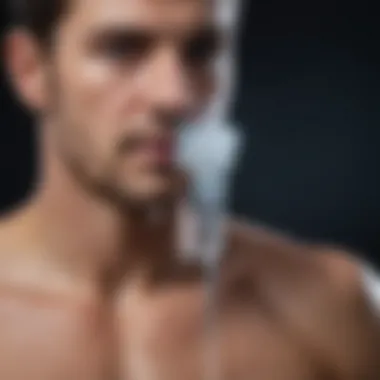Exploring Water Vapor Therapy for BPH Treatment


Intro
Benign prostatic hyperplasia (BPH) poses significant challenges for many men, particularly those in their middle to later years. This condition leads to varied urinary symptoms that can adversely affect daily living. As medical advancements continue to evolve, new treatments emerge, promising a better quality of life for patients. One such innovative approach is water vapor therapy. This minimally invasive procedure not only alleviates symptoms but does so with reduced complications compared to traditional interventions.
In this article, we will explore water vapor therapy for BPH, shedding light on its mechanisms, effectiveness, and future directions in clinical practice. By understanding the nuances of this treatment, healthcare professionals can make informed decisions to enhance patient outcomes.
Research Overview
Methodological Approaches
Water vapor therapy employs a technique called thermal tissue ablation, which utilizes steam to destroy hyperplastic prostate tissue. The method is guided by ultrasound imaging, ensuring precision in targeting affected areas. Research on this technique often combines clinical trials, patient surveys, and comparative studies. These methodologies allow for a thorough examination of effectiveness and safety profiles against older treatment modalities like transurethral resection of the prostate.
The outcomes reviewed in various studies indicate promising results, with high satisfaction rates reported by patients post-procedure. Such findings are significant as they suggest water vapor therapy could become a standard option for treating BPH.
Significance and Implications
The introduction of water vapor therapy carries significant implications for both patients and healthcare providers. The reduced recovery time associated with this treatment allows for quicker return to daily activities. Furthermore, by minimizing the risk of complications, it positions itself as a favorable alternative for many patients who may not be suitable candidates for more invasive surgeries.
Water vapor therapy presents a new paradigm in the management of BPH, emphasizing patient safety and improved quality of life.
Current Trends in Science
Innovative Techniques and Tools
The advancement of technology plays a crucial role in the efficacy of water vapor therapy. Modern flexible cystoscopes and precise temperature regulation systems have improved the accuracy of this treatment. Researchers are continually seeking to refine these tools, enhancing both efficacy and patient safety.
Additionally, ongoing studies investigate various patient profiles to establish optimal criteria for treatment selection. Insights gained from these studies will likely shape future guidelines related to water vapor therapy.
Interdisciplinary Connections
Research surrounding water vapor therapy is not confined to urology alone. The impact of interdisciplinary collaborations is evident. For instance, partnerships with biomedical engineers can lead to the creation of more efficient tools and techniques. Similarly, discussions with pharmacologists may enhance the understanding of how medications can complement treatment procedures.
Preamble to Benign Prostatic Hyperplasia
Benign Prostatic Hyperplasia (BPH) is a common condition that affects older men as prostate tissue expands, often leading to urinary symptoms. Understanding BPH is crucial as it offers insight into possible complications and treatment pathways. This section emphasizes the significance of BPH, given its prevalence and impact on life quality.
Definition and Prevalence of BPH
BPH is defined as a non-cancerous enlargement of the prostate gland. This condition results from hormonal changes associated with aging. Studies indicate that approximately 50% of men aged 51 to 60 experience BPH symptoms, which increases to 90% among those over 80. These statistics reinforce the need for awareness and potential interventions.
Symptoms and Impact on Quality of Life
The symptoms of BPH primarily include frequent urination, increased urgency, and difficulty starting or stopping urination. These discomforts can severely affect daily activities and emotional well-being. Men may experience sleep disturbances due to nighttime urination, which can lead to fatigue and reduced productivity.
"BPH is not merely a medical issue but a quality-of-life concern, impacting social relationships and mental health."
Traditional Treatment Options


Traditional treatment methods for BPH include lifestyle changes, medications, and surgical options. Common medications are alpha-blockers such as Tamsulosin, which help relax the prostate muscles. Surgical interventions can range from less invasive techniques to more extensive procedures like Transurethral Resection of the Prostate (TURP). However, these treatments come with potential side effects and longer recovery times.
Understanding these traditional treatments sets the stage for exploring innovative therapies like water vapor therapy, which is less invasive and carries a different risk profile. By addressing the foundational knowledge of BPH, we can better appreciate the advancements in treatment that aim to improve patient outcomes.
Understanding Water Vapor Therapy
Water vapor therapy is an innovative approach for treating benign prostatic hyperplasia (BPH). This subsection will explain its significance as a modern medical treatment, focusing on specific elements and benefits that make it stand out among traditional therapies. BPH, characterized by the enlargement of the prostate gland, can lead to urinary issues and significantly impair an individual's quality of life. As a response, medical professionals have sought various treatment modalities, and water vapor therapy has emerged as a minimally invasive technique with notable efficacy.
One of the critical elements in understanding water vapor therapy is its mechanism of action. Unlike traditional treatments that rely on surgical excision or medication, this therapy uses steam to precisely target prostate tissue. The localized application of water vapor creates a thermal reaction that ultimately leads to tissue ablation, reducing the volume of the enlarged prostate and alleviating urinary symptoms. This focused approach minimizes surrounding tissue damage, contributing to lower complication rates.
In addition, the procedure overview highlights how water vapor therapy is performed. The technique is conducted in a controlled clinical environment. It usually involves the insertion of a specially designed device into the urethra under sedation or local anesthesia. The device then releases steam directly into the prostate tissue, which destroys excess tissue while preserving healthy structures. This precise targeting not only improves safety but also encourages faster recovery, setting water vapor therapy apart as an advantageous option when compared to traditional surgical methods.
"Water vapor therapy not only offers patients rapid relief from symptoms but also minimizes risk, making it a compelling option for many men suffering from BPH."
Furthermore, water vapor therapy significantly reduces recovery time. Patients can often return to their normal activities within a few days, a stark contrast to the longer recovery periods associated with more invasive surgical procedures. The lower risk of complications, such as bleeding or infection, further solidifies its place as an attractive option.
In summary, understanding water vapor therapy involves grasping its innovative mechanism of action and the efficient procedure it offers. This approach represents a shift towards less invasive treatments within urology and reflects the ongoing advancements in medical technology. As the medical community continues to explore its potential, water vapor therapy's role in BPH management is poised to expand, benefiting both healthcare providers and patients.
Clinical Evidence Supporting Water Vapor Therapy
The exploration of clinical evidence supporting water vapor therapy for benign prostatic hyperplasia (BPH) is crucial. This aspect addresses the therapy's effectiveness and aids in understanding its acceptance in the medical community. By analyzing studies and data, healthcare providers can make informed decisions about treatment options for patients suffering from BPH. The scrutiny of clinical evidence not only enhances patient care but also highlights the significance of continual research in this field.
Effectiveness in Symptom Relief
Water vapor therapy is designed to relieve urinary symptoms associated with BPH. Multiple clinical trials have confirmed its ability to alleviate these obstructive symptoms effectively. In a controlled study involving a significant number of participants, researchers reported improvements in urinary flow and reductions in residual urine volume. Notably, patients often experience relief soon after the procedure, emphasizing the therapy's rapid onset of action.
- A common measure of effectiveness includes the International Prostate Symptom Score (IPSS). Studies show that patients score significantly lower on the IPSS scale post-treatment.
- Furthermore, long-term follow-ups indicate sustained improvement in symptoms, often lasting for years without the need for additional interventions. This fortitude underscores the relevance of water vapor therapy as a viable alternative to traditional methods.
Comparative Studies with Other Treatments
When comparing water vapor therapy to traditional treatments such as transurethral resection of the prostate (TURP) and medications, the evidence presents a compelling case. Research demonstrates that water vapor therapy provides similar or even superior outcomes in terms of symptom relief with fewer side effects.
- Studies have shown:
- In addition, water vapor therapy minimizes the risks associated with anesthesia, making it an attractive option for patients who may be at risk due to comorbidities.
- Reduced complication rates compared to TURP, including lower rates of bleeding and hospitalization.
- Shortened recovery times, allowing patients to return to normal activities sooner.
"Water vapor therapy is proving to be an effective treatment avenue for BPH patients who seek relief without the invasiveness of traditional surgical methods."
Patient Selection for Water Vapor Therapy
Selecting appropriate patients for water vapor therapy is crucial for maximizing the effectiveness of treatment while minimizing associated risks. As with any medical intervention, identifying which patients will benefit most is an essential step in achieving successful outcomes. This section explores the criteria guiding suitable patient selection and emphasizes the importance of a personalized approach.
Ideal Candidates
Water vapor therapy is ideally suited for patients suffering from benign prostatic hyperplasia (BPH) who meet specific conditions. These include:
- Age: Typically, patients should be over 50 years old, as BPH is more prevalent in the older demographic.
- Symptom Severity: Candidates generally present with moderate to severe urinary symptoms that significantly affect their quality of life, such as frequent urination, urgency, and nocturia.
- Prostate Size: Ideal candidates often have a prostate size that does not exceed 80 mL, as larger prostates may require more invasive treatments.
- Failed Conservative Treatments: Patients who have not found relief through medication or other non-invasive methods become prime candidates for water vapor therapy.
Understanding the specific needs and conditions of patients helps identify those who will most likely benefit from this treatment.


Contraindications
It is equally important to consider who is not suitable for water vapor therapy. Certain factors can make this method inappropriate for some individuals. Contraindications include:
- Acute Urinary Retention: Patients in acute retention may need more immediate and invasive interventions.
- Severe Comorbidities: Those with serious health conditions, such as uncontrolled diabetes or heart diseases, may be at higher procedural risks.
- Prostate Cancer: Patients with active prostate cancer must be evaluated through different treatment pathways rather than water vapor therapy.
- Recent Urethral Surgery: Individuals who have undergone urethral surgery recently should avoid this therapy as it may exacerbate complications.
It is crucial for clinicians to perform a thorough evaluation to determine if patients meet both the inclusion and exclusion criteria. Through careful consideration of these factors, healthcare professionals can enhance the reliability and safety profile of water vapor therapy while ensuring focused and effective patient care.
"A comprehensive selection process plays a considerable role in optimizing treatment outcomes, allowing patients to experience symptom relief efficiently and with reduced risk."
This method’s effectiveness hinges upon identifying suitable candidates and acknowledging those at risk, guiding personalized treatment planning.
Benefits of Water Vapor Therapy
Water vapor therapy offers significant advantages in the treatment of benign prostatic hyperplasia (BPH). Understanding these benefits is critical for patients and healthcare providers evaluating treatment options. The specific elements at play include its minimally invasive nature, reduced recovery time, and a lower risk of complications. Each of these aspects contributes to a more favorable patient experience while addressing the uncomfortable symptoms of BPH.
Minimally Invasive Nature
One of the most notable benefits of water vapor therapy is its minimally invasive nature. This procedure involves delivering steam directly to the prostate tissue, effectively reducing the size of the gland without requiring extensive incisions or major surgical interventions. Because the technique is less invasive, it generally leads to less trauma for the patient. With minimal disturbance to surrounding tissues, this approach can result in not only less pain but also decreased bleeding during and after the procedure.
The benefit of this method is largely evident when compared to traditional surgical options like transurethral resection of the prostate (TURP). Many patients prefer options that do not involve prolonged hospital stays or complicated recovery processes. According to recent studies, patients undergoing water vapor therapy report higher satisfaction following this intervention than those undergoing more invasive procedures.
Reduced Recovery Time
In addition to being less invasive, water vapor therapy typically correlates with a faster recovery time. Patients usually experience minimal discomfort and are often able to resume daily activities shortly after the procedure. This reduced recovery period is advantageous for men who wish to return to their normal life without prolonged downtime.
Clinical data indicate that most patients can expect to leave the clinic within hours after their treatment. The rapid recovery makes this an attractive option for many, particularly for those who are balancing work and personal commitments.
Moreover, with shorter recovery times, fewer follow-up visits are necessary, enhancing the overall appeal of this treatment approach.
Lower Risk of Complications
Finally, the lower risk of complications is an important aspect of water vapor therapy. Traditional options for BPH treatment can lead to various side effects, including urinary incontinence and sexual dysfunction.
However, the targeted nature of steam ablation aims to minimize these adverse outcomes. Most patients discover that their post-treatment experiences are more benign compared to alternative surgical methods. The precision of water vapor therapy reduces the probability of damaging surrounding tissues, which subsequently leads to a decrease in potential complications.
According to reports, the incidence of severe side effects following water vapor therapy is lower than that seen with TURP and laser therapies, making it a safer choice for many.
"Water vapor therapy retains the efficacy needed to alleviate the symptoms of BPH while offering a combination of benefits not easily found in other treatments."
In essence, the benefits of water vapor therapy present a compelling case for its use as an alternative treatment for benign prostatic hyperplasia. The combined effects of its minimally invasive nature, reduced recovery times, and lower complication risks make it a promising choice for many patients faced with BPH.
Limitations and Considerations of Water Vapor Therapy
Understanding the limitations and considerations of water vapor therapy is crucial for a balanced perspective on its application in treating benign prostatic hyperplasia (BPH). While this treatment method shows promise, it is important to account for various factors that may impact its efficacy and patient experience. Painstaking consideration of these aspects can guide healthcare professionals in making informed decisions when incorporating this technique into standard practice.
Potential Risks and Side Effects


Even though water vapor therapy is regarded as a minimally invasive solution, it is not devoid of risks. Some of the potential risks include:
- Urinary Retention: In some cases, patients may experience temporary difficulty in urinating post-procedure. This can necessitate further interventions.
- Infection: As with any procedure that involves the urinary tract, there exists a risk of infection. Proper post-operative care is essential to mitigate this.
- Erectile Dysfunction: Although rare, some patients may report changes in sexual function, which can lead to psychological distress.
- Bleeding: Minor bleeding can occur, though it typically resolves without the need for intervention.
Understanding these potential side effects is essential for both patients and practitioners. Discussions regarding these risks should occur prior to undertaking the procedure to ensure realistic expectations and preparedness.
Long-term Effectiveness
Assessing the long-term effectiveness of water vapor therapy poses challenges. Current research offers varying insights, indicating a need for ongoing studies. Key considerations include:
- Sustainability of Symptom Relief: While initial studies demonstrate positive results in symptom relief, the duration of these effects remains a pivotal discussion point. Continuous evaluation of patient outcomes over time is necessary to determine long-term viability.
- Need for Retreatments: A subset of patients may require additional treatments to maintain symptom control. Understanding the frequency and reasons for retreatments helps shape future therapeutic strategies.
- Comparative Analysis: As therapies evolve, comparing water vapor therapy's long-term results with alternative treatments like transurethral resection of the prostate (TURP) is fundamental. This allows for informed decisions on optimal care pathways.
In summary, while water vapor therapy presents as a viable treatment option for BPH, awareness of its potential limitations, risks, and long-term effectiveness is necessary. Patients should be adequately informed, and ongoing research is imperative to ensure the refinement and enhancement of this therapeutic approach.
Future Directions in Water Vapor Therapy Research
Research in water vapor therapy is crucial to understanding its full potential and expanding its reach in medical practice. The exploration of this technique will pave way for improved therapeutic methods and enhance patient care in treating benign prostatic hyperplasia (BPH). Since BPH affects a significant number of men, addressing its long-term management is vital. Understanding future innovations in this field could lead to better outcomes and greater efficiency in operations, ultimately impacting quality of life positively.
Innovations in Technique
New technologies are continually being developed to enhance the effectiveness of water vapor therapy. One such innovation is the refinement in delivery systems. Improved devices allow for better precision in administering steam, targeting specific areas of tissue with minimal impact on surrounding structures. This can reduce recovery time and enhance overall results.
The introduction of robotic-assisted techniques may also provide enhanced control during procedures. As these methods evolve, they could allow for more tailored treatments, adjusting to individual patient anatomical differences. Other innovations may include the integration of imaging technologies, aiding in real-time monitoring during the treatment process.
Such advancements are important as they can lead to:
- Increased safety: Minimizing damage to healthy tissues.
- Enhanced effectiveness: Targeting the prostatic tissue more accurately.
- Reduced hospital stays: Encouraging same-day discharge where appropriate.
Expanding Applications Beyond BPH
While the primary focus of water vapor therapy has been on treating BPH, its applications could potentially extend beyond this condition. Research indicates that similar techniques could be adapted for other urological conditions, including bladder outlet obstruction or urethral strictures.
Furthermore, its principles may eventually be applied to treat other types of benign prostatic conditions, as well as pathologies in different organs. The adaptability of the water vapor modality creates opportunities for broader therapeutic applications. Exploring these areas could lead to:
- Broader treatment options: Benefiting more patients who suffer from various conditions.
- Multi-disciplinary approaches: Enhancing collaboration between urology and other medical fields.
- Cost-effectiveness: Offering alternative treatments that might require less intensive care and lower overall costs.
Finale
In this article, the exploration of water vapor therapy for benign prostatic hyperplasia (BPH) has illuminated several critical facets of this innovative treatment. The relevance of this discussion cannot be overstated. Water vapor therapy stands out as a minimally invasive option that promises not only symptom relief but also a significantly reduced risk of complications compared to traditional methods.
Summary of Key Findings
The evidence presented supports the effectiveness of water vapor therapy in alleviating the urinary symptoms associated with BPH. Key findings from clinical trials indicate that this therapy leads to substantial improvements in patients’ quality of life, alongside favorable safety profiles. Many patients reported better overall satisfaction post-procedure, highlighting a transition towards more patient-centered care options in urology. Furthermore, the treatment is marked by shorter recovery times and fewer side effects compared to more invasive alternatives, such as surgical procedures.
"Water vapor therapy is redefining treatment modalities for BPH, showcasing not just efficacy but a commitment to patient safety and comfort."
Implications for Clinical Practice
The insights gained from the study of water vapor therapy carry significant implications for clinical practice. Urologists and healthcare providers may find this method as a viable first-line treatment for eligible patients with uncomplicated BPH. The benefits of a minimally invasive approach can streamline the management of this common condition, making it easier for patients to engage in their treatment plans. However, it is important for practitioners to remain vigilant regarding patient selection and to be aware of potential contraindications to ensure optimal outcomes. As ongoing research continues to refine techniques and expand the understanding of water vapor therapy's applications, practitioners should remain adaptable and informed.
Related Resources:
By providing a clear and almost exhaustive reference list, the integrity of the information presented is secured, leading to improved discourse not just on water vapor therapy but on the complex world of benign prostatic hyperplasia.



